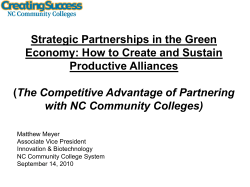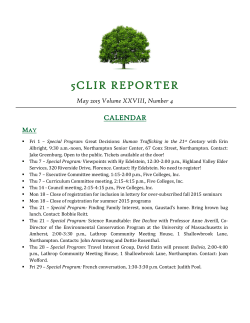
- Rich Gross Solutions
10 THINGS YOUR COMMUNITY COLLEGE SHOULD BE DOING NOW BY RICHARD GROSS, PH.D. Institutional Advancement Has Evolved Institutional advancement has evolved over the past decade and has taken on additional importance and value for the future of the community college. In addition to generating revenue, properly conducted campaigns also result in new programs and services aligned to the changing needs of the region, new or extended public and private partnerships, and serve as a vehicle to build the institutional brand. A well designed development strategy can impact not only the college’s success, but also that of the region. This document takes a look at how the Community College Development Cycle has evolved and what colleges should be doing to accelerate institutional advancement. www.RichGrossSolutions.com :: 2 / Board Development 1. Alignment Community College Then: Community colleges rarely if ever took stock of their internal stakeholders views about either the quality of institutional performance or the importance Development Cycleof performing well. Now: Community colleges are beginning to recognize that successful planning means all members of the college team have the same understanding of the mission, performance, and importance of the institutional vision, mission, goals, and initiatives. 2. Legislative Relationships Then: Investing time in identifying a few key grant opportunities for the college. Also, occasional visits to the statehouse to lobby for bills that supported community college funding and programs. Now: Grant development means working with a wide variety of public and private funders, developing long term relationships with key foundations that provide not only the largest grants, but also with community foundations directing donor-advised funds, Legislative relationships is more than lobbying. It means building ongoing relationships with elected officials, including them in college activities, and pro-actively working with legislative committees, members of the executive branch, and others that can help generate future legislative priorities in support of the community college. www.RichGrossSolutions.com :: 3 / Board Development Community 3. Leadership/Board College Development Development Cycleboards were considered separate Then: Foundation and governing entities, often moving in different directions. Now: Community colleges understand that both boards, as well as the leadership team, advisory committees and others must share the same understanding of institutional direction. They are all part of the same team. Additionally, they must have the same tools and means of communication in order to help the college succeed. 4. Community Engagement Then: Community colleges mostly relied on program advisory committees and occasional discussions with community leaders in order to keep programs and services relevant to regional needs. Now: Community colleges understand that they, like private sector industry sectors, operate in a dynamic fast changing environment. They must have processes in place for continuous evaluation of the environment in which they work. Also, they must engage in ongoing partnerships in order to have the necessary tools to respond to that environment. www.RichGrossSolutions.com :: 4 / Board Development Community College Development Cycle 5. Planning/Visioning Then: Planning was something that was done as a requirement of accrediting agencies, often involving a few key staff. Most often the resulting plan sat on a shelf until the next planning cycle. Now: Community colleges understand that their vision and plan must be part of the plan and vision of the larger community that they serve. It needs to employ tactics, not just flowery language, that are ongoing, outreaching, and inclusive in order to succeed. Plans can no longer sit on shelves, but must be part of all aspects of institutional decision-making. 6. Development Assessment Then: The development assessment process primarily centered on the effectiveness of the institutional advancement office and how well that office was able to generate contributions for scholarships. The main role of the office was to engage in special events and other annual campaign activities. Now: Development is no longer confined to that office. Revenue generation is a key ingredient of all aspects of institutional behavior and goal-setting. Institutional development now includes all aspects of planning, outreach, and performance. www.RichGrossSolutions.com :: 5 / Board Development Community College Development Cycle 7. Feasibility Study Then: Feasibility studies primarily consisted of interviewing some key stakeholders to test the initiatives and financial goals of a potential campaign, and to use that information to help form a plan of campaign. Now: While those elements of a feasibility study continue to be maintained, community colleges realize that this form of outreach can also be used to assess perceptions about the institution, its performance and the strength of its brand. It can also be used to conduct community summits that can help form new partnerships and opportunities. www.RichGrossSolutions.com :: 6 / Board Development Community College Development Cycle 8. Campaigns Then: Major Gifts, Capital, and Targeted campaigns focused primarily on engaging a few key influential and affluent stakeholders and employing strategies for garnering their investment in college fundraising activities. Now: While engaging influential and affluent stakeholders is still vitally important, the campaign takes on added importance and value. In addition to generating revenue, properly conducted campaigns also result in new programs and services aligned to the changing needs of the region, new or extended public and private partnerships, and serve as a vehicle to build the institutional brand. www.RichGrossSolutions.com :: 7 / Board Development Community College Development Cycle 9. Stewardship Then: Stewardship meant providing donors with quarterly newsletter and occasional social activities as a means to thank them for their support and to help encourage their future financial investments in the college. Now: While thanking donors/investors and encouraging ongoing support is still an important component of stewardship, it now also includes strategies for facilitating increased commitment to new or existing partnerships, involving key stakeholders in ongoing review of community college performance, and to stay abreast of changing dynamics in the region. www.RichGrossSolutions.com :: 8 / Board Development Community College Development Cycle 10.Assessment Then: Institutional assessment was primarily conducted in response to accrediting agency requirements, state requirements, or grant requirements. Now: Assessment of institutional progress and achievement is fundamental to the entire process of moving the institution toward alignment and in preparing for the entire institutional development cycle. www.RichGrossSolutions.com :: 9 For a customized look at your institutional advancement goals, contact us at 855.274.1511 or email me at rich@rgs24.com. 27426 Cedar Road // Hot Springs, SD 57747 www.RichGrossSolutions.com
© Copyright 2025











